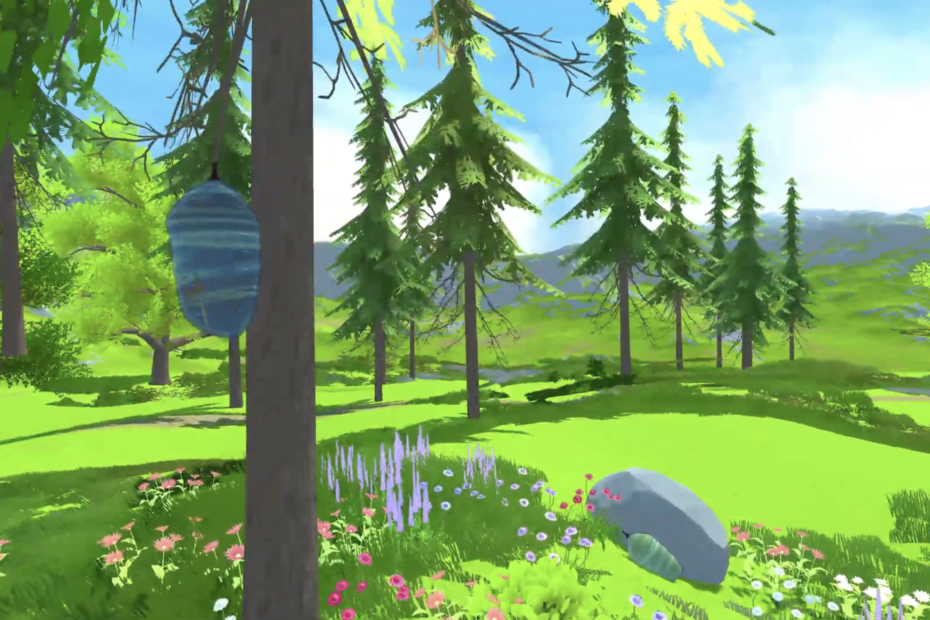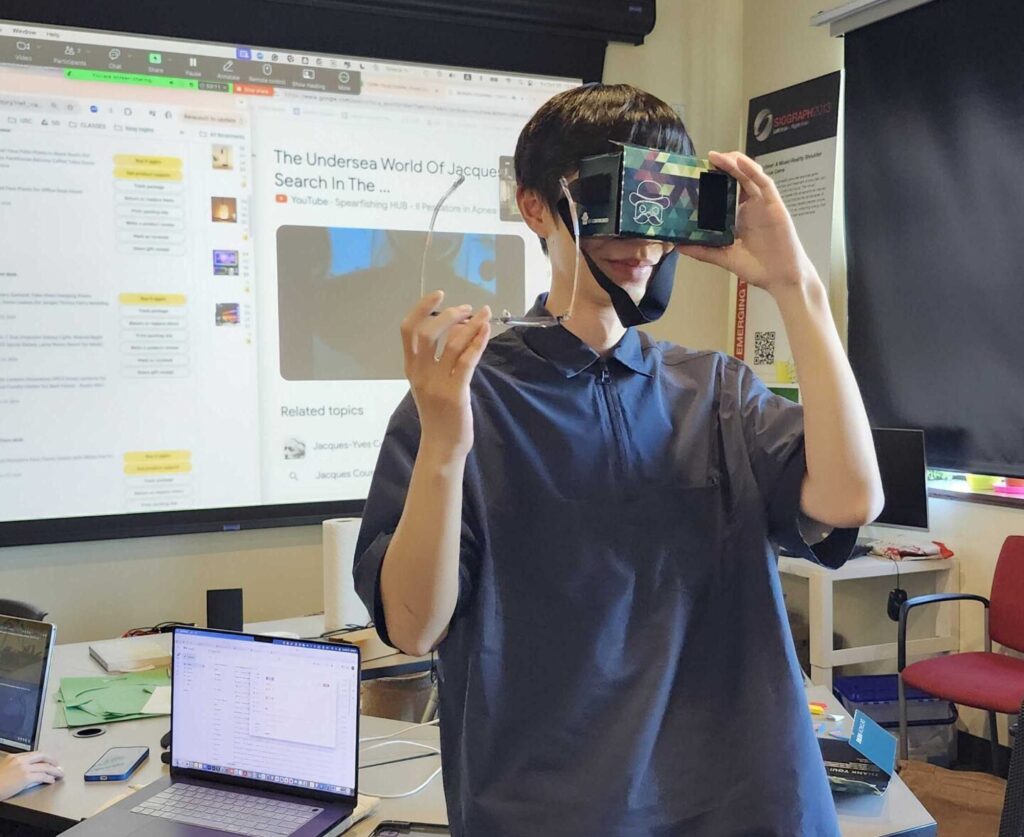Editorial by Malini Adkins –
[ COVER IMAGE: Still from Dina’s immersive video of a butterfly transformation created in the Unity3D game engine.]
Our “Virtual Reality Memorial” project is a proud collaboration with the USC Keck School of Medicine and LA General Medical Center’s Women’s Clinic and the Wellness Center. With support from USC Arts in Action, we are producing media arts memorial pieces for gynecological cancer patients while striving to highlight the impact of media arts expression and the preservation of legacy. We hope to provide a distinctive opportunity for underrepresented patients to lend their voices in a way that assigns a new variable to palliative care, which has the potential to open up new avenues for this specialized form of medical care.
Clear communication regarding patients’ treatment decisions is pivotal in cancer care, especially in advanced settings. Thus, developing these interpersonal connections contributes to the accessibility of palliative care for patients. However, many palliative care interventions are less accessible to patients with limited English proficiency. This is where the VR Memorials project aims to shed light.
Inspired by various projects like Massachusetts CultureRX and social prescribing initiatives abroad, we aim to provide legacy-making practices (interviews, letter writing, and “media arts on behalf” workshops) into palliative care. This revolutionizes the practice of traditional art therapy by evolving it into a human-centered and socially engaged framework. Within the first year, these legacy pieces have already culminated into an art installation that has taken the wishes and insights of these patients and has exhibited them into featured curated works.
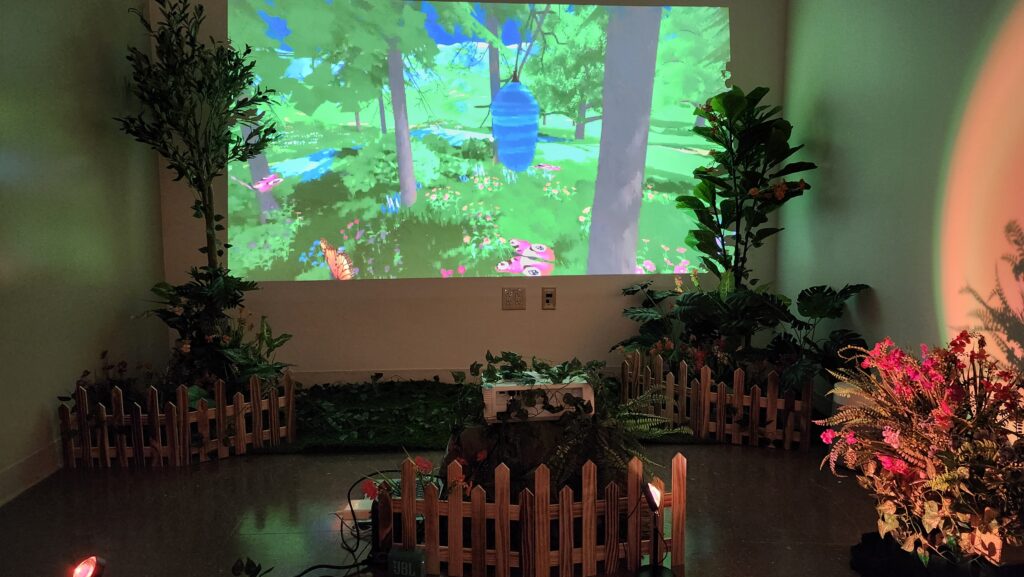
Dina’s immersive media installation piece at the “Celebration of Life” exhibition, hosted by the LAGMC Wellness Center. (Photo courtesy of CM&BHC)
During our initial introductory meetings in May 2024, the arts and medicine team collaborated to distill the medical team’s interview transcripts into detailed documentation for the patient’s letter and the media art pieces. For context, at that point, five patients had been interviewed by medical staff using the “Dignity Therapy” and “Stanford Life Review” questions. Through this framework, patients detail the most important people in each of their lives, and their most treasured moments, if they want to apologize to their loved ones and offer their forgiveness. Furthermore, patients are encouraged to express their gratitude and tell loved ones how much they love them before finally saying goodbye.
The interview data is used to compose an informative transcript that the medical team creates for the art team to review internally. The goal of this record is to create a letter, written from the perspective of the patient, that would chronicle these findings in their own words. While there is no objective measurement of how long patient interviews should be, they typically last between 30 minutes to 1 hour. Furthermore, the number of interviews largely varies depending on the patient’s needs – some patients may only require two interview sessions between both the art team and the medical team. Others require multiple interviews. Nonetheless, the goal is still the same – it’s an opportunity to allow patients to take ownership of their narrative to obtain closure for both themselves and their loved ones.
The two patients the team largely focused on during the first half of the first year were Felicity* and Dina*. Since Felicity and Dina finalized their interview transcripts, the art team worked on both letters over the next few months. This involved consistently meeting with both patients to capture the right tone in each letter. The letters were also shared in drafted stages so that the patient could provide their edits to the material every step of the way. This process emphasized a strong sense of collaboration and open communication. As soon as the patients provided their final seal of approval, the written content went on to be used as the “heartbeat” for Felicity and Dina’s design pieces. Specifically, their core narratives began to truly illuminate as part of their legacy.
Xiongju Sun testing Google Cardboard VR for Dina’s immersive media piece during design workshops. (Photo courtesy of CM&BHC)
At the Garden Lab of the Creative Media & Behavioral Health Center, our students and volunteers thoroughly examined and discussed all of the documentation on Felicity and Dina in order to create original artwork that captured their spirit and life experiences. While these legacy pieces were originally intended to be confined to the VR environment, it is important to note that these design creations are no longer limited to VR – this gives the art team the flexibility to expand their creativity to other storytelling mediums. Once the team decided to expand their ideas to art pieces outside of VR, they were able to come up with two distinct pieces that embody both patients at an individual level. Also, much like the creation of the letters, Dina and Felicity were invited to review the content throughout each iteration before they gave their approval of the material.
Dina’s artwork is an immersive media piece that allows her loved ones to enter an experience that journeys them through a story that symbolizes Dina’s perception of the world and the values she holds close to her. With Dina having a strong connection to butterflies, as they represent “transformation” and “rebirth”, users who interact with her artwork will be able to step into the perspective of a caterpillar that undergoes a metamorphosis. Once this beautiful butterfly flies out into the world, the audience can witness other butterflies surrounding them. In Dina’s mind, this is meant to represent Dina’s loved ones, which demonstrates the support that they will provide for her as they continue to venture through life. The art team drafted many media variations and incorporated various assets into the legacy piece. In addition to the coding and technical development for Dina’s artwork, the team also curated artificial greenery, lighting, and scents to thematically dress the world within her room at the Celebration of Life event.
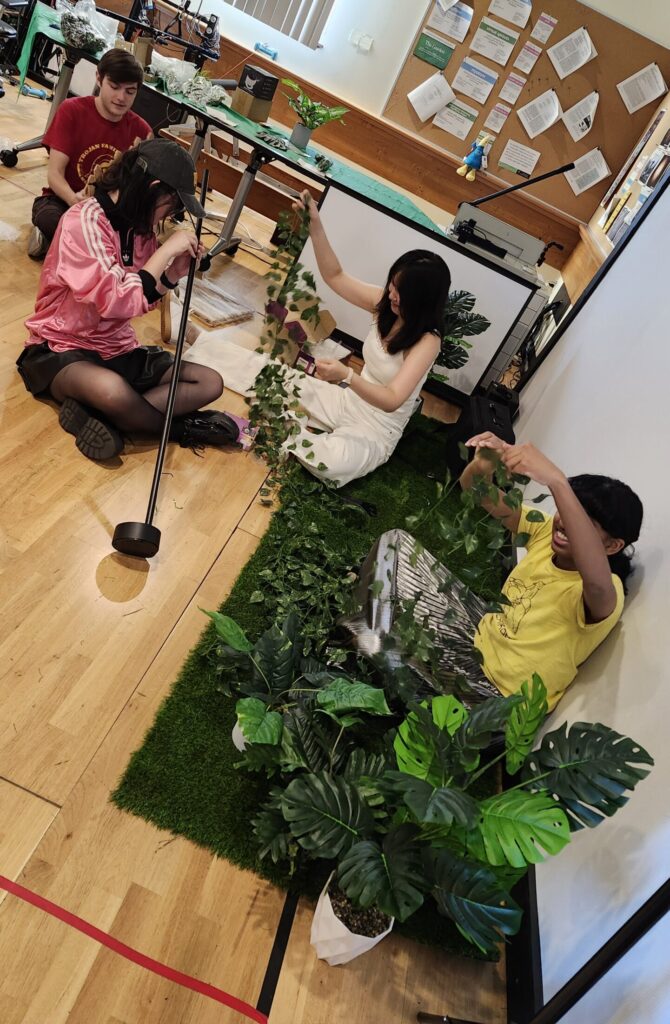
Frank Perazzini, Yixie Xie, Kiwi Li and Anik Panja putting together pieces of Dina’s art installation. (Photo courtesy of CM&BHC)
For Felicity’s installation, the art team scripted and storyboarded a narrative that is loosely based on one of Felicity’s original short stories. The content derives from Felicity’s most cherished memories, and her children are featured in each of the illustrations. These artistic drawings were coupled with mementos that Felicity holds close to her. Felicity was included in each plan of action, offering feedback on anything that she wished to be included or omitted. All of these artifacts were printed, curated, and displayed in her room during the Celebration of Life event.
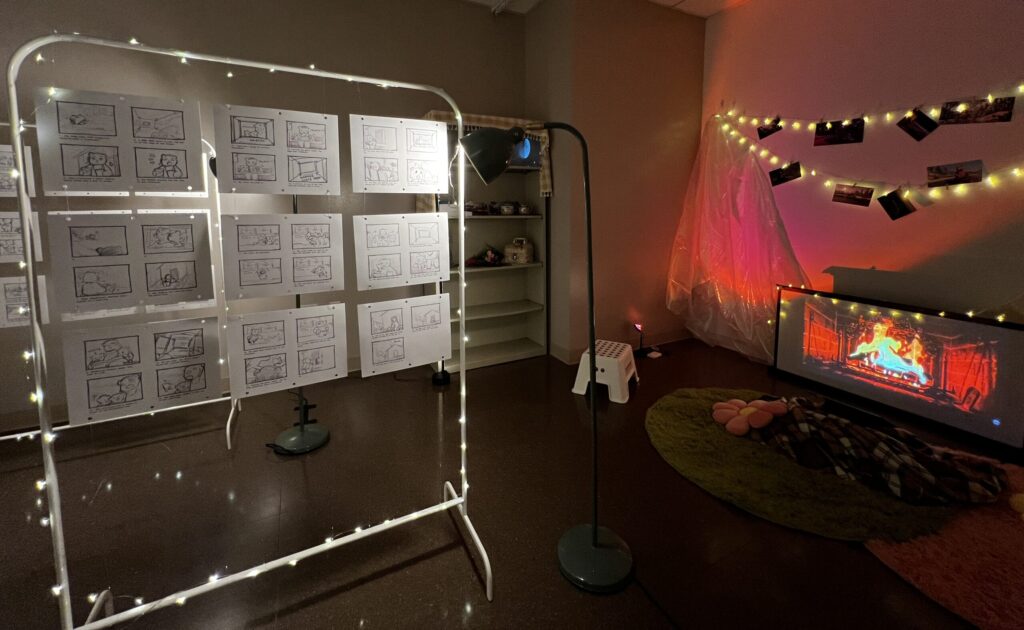
Felicity’s art room during the “Celebration of Life” exhibition, hosted by the LAGMC Wellness Center. (Photo courtesy of CM&BHC)
This research project exemplifies how nuanced palliative care can be in a healthcare setting. This initiative offers an opportunity to critically examine the role that artistic expression can play in specialized medicine. This is especially important when we channel this towards underrepresented communities that are not often given the space to fully express themselves. This blend of palliative care with media arts is an experience that provides comfort for patients and loved ones and offers a sense of closure that many are not given a chance to obtain. Furthermore, in the case of this particular project, these complex steps build off each other in a precise fashion. This makes each process incredibly critical when creating legacy pieces for each patient.
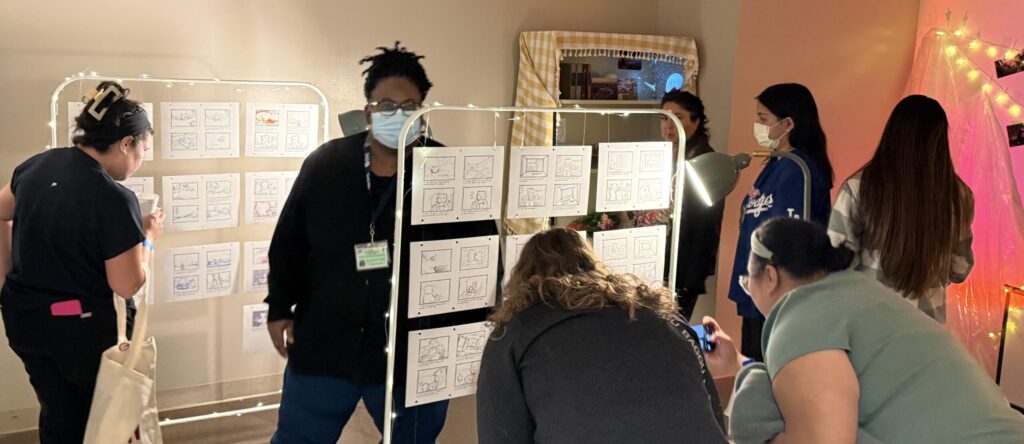
Staff from the LAGMC Women’s Clinic walking through Felicity and Dina’s installation at the “Celebration of Life” exhibition. (Photo courtesy of CM&BHC)
Finally, the most important element of this project is how involved patients get to be throughout the production of each material. Creating these legacy pieces allowed both patients to gain a sense of agency over what both teams aimed to accomplish. This process is aligned with patient advocacy in that patients are encouraged to openly offer ideas and expectations of what they want. Even if patients are not entirely sure about what they want, both teams make sure to extensively interview them so that they can gain a deep understanding of what truly embodies them. Ultimately, the goal is to take these ideas from fruition to reality and to bring to life patient experiences in a way that will memorialize them until the end of time.
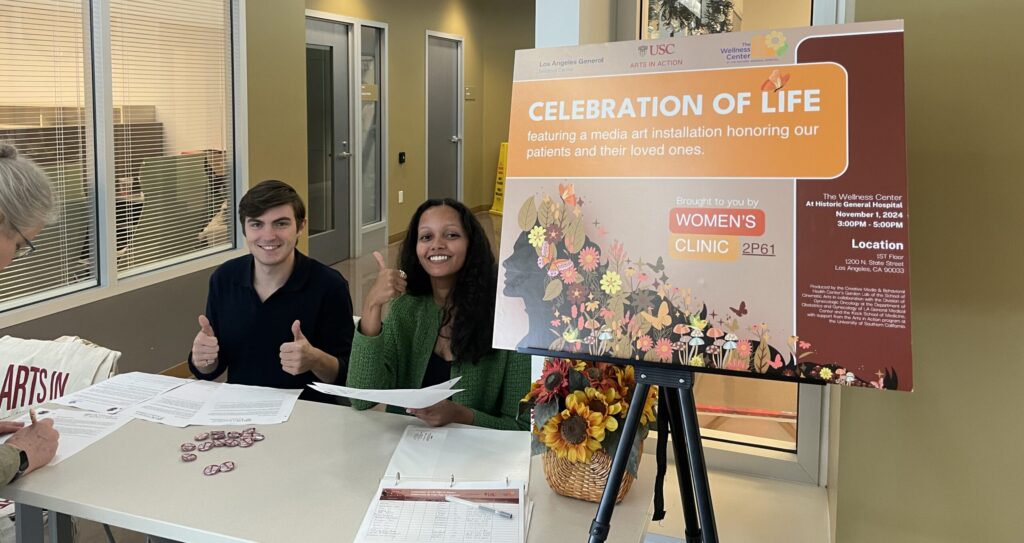
Frank Perazzini and Malini Adkins at the opening of the media art installation “Celebration of Life” as part of the “VR Memorial” project. (Photo courtesy of CM&BHC)
USC Arts in Action has approved a second year of support (Immersive Legacy Memorials), during which we plan to switch to a bedside model of “media arts on behalf,” with the letter-writing process being optional, which may appeal to more patients and require fewer resources to execute. We also plan to curate installations at the clinic and build more partnerships for sustainability.
*Names have been changed for anonymity
